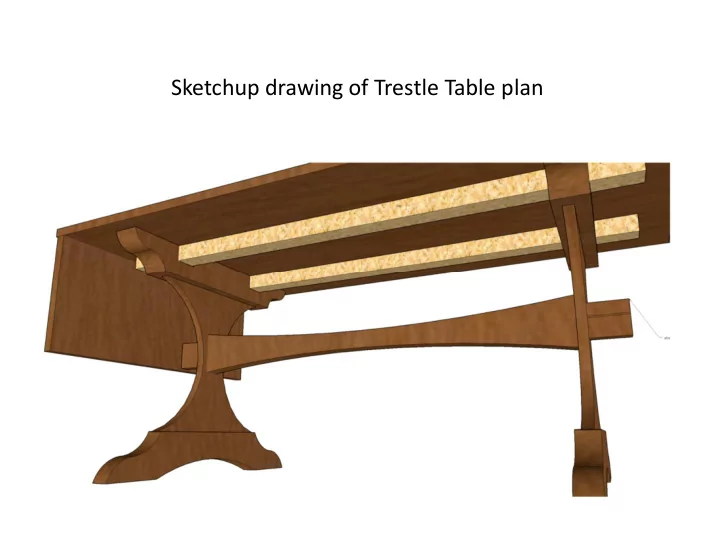

Sketchup drawing of Trestle Table plan
Bottom: Legs and stretcher waiting for the table top to be lowered onto the tenons on the top of the legs.
Assembled trestle Table with foremost leaf open. final table.jpg
Bubinga is oily. Scrub with Acetone to Release surface oils to be replaced with IMG_0159.jpeg hardening tung oil. Eight IMG_0159.jpeg IMG_0159.jpeg brushed on coats of floor grade poly-U. Final sanding to 6,000 grit. >Use wipe- no/wipe off gel varnish
Stock Bubinga
Trestle table’s base
Cleat Leg
Chopping a mortise in the floating tenon for the wedge. The board was too wide to use a mortising machine. Chop from both sides and meet in the middle. Making the 4” deep mortise accept this tenon was difficult.
Box Joint hinge requires 18” straight hole. Too long to bore. Rip into 6” boards: 6” straight hole OK 8’ ancillary fence Paul’s thickness planer caused tear-out. Justify subsequent measure- ments against the top surface and sand later. Used glue-ready Freud 19” rip blade Six floating tenons /rip joint: Justify against top surface. Acetone before epoxy
Final hinge Realize the top surface was sanded flat after the hinge was made.
1” dia. 3/8” dia. 1/2” 3/16” 5/16” <-Reference Surface, eventual table-top-> Hinge design: the 1” Forstner bit and the 3/8” brad-point bit are aligned to the end and table top surface using brass machinist’s standards.
Clamped up for hinge boring using Shopsmith horizontal boring capability.
3” deep 1” diameter hole Forstner bit
3” deep 1” bore requires a long shank Forstner bit. Without realigning wood or chuck, change to a 3/8” brad point bit for the 6” x 3/8” pivot hole.
Bored ends ready for routing
Routing the bored ends with a bull-nosed bit referenced against the top’s surface. Ends are mutually aligned with a dowel through the pivot hole. The 36” stretch is protected on the sides with MDF and routed in small increments.
Final bull- nosed router cut before inserting floating tenons and edge-gluing pairs of boards.
Touching up the hinge with custom-ground carving tool. Take to industrial surface Sander with the leaves attached by dowels before the final pass.
Wenge inlay: dado was made with a track saw followed by routing. Note continuous grain across hinge joint.
Mortised cleats affixed with screws near center. All else with table-top fasteners. Note fastener to bring together separating boards. Mortises to fit on the tenons on the legs
Leaf extended and locked open with T- track system. Table top is ready to be carried by two strong neighbors into dining room and its awaiting base
Bottom: Legs and stretcher waiting for the table top to be lowered onto the tenons on the top of the legs.
Recommend
More recommend